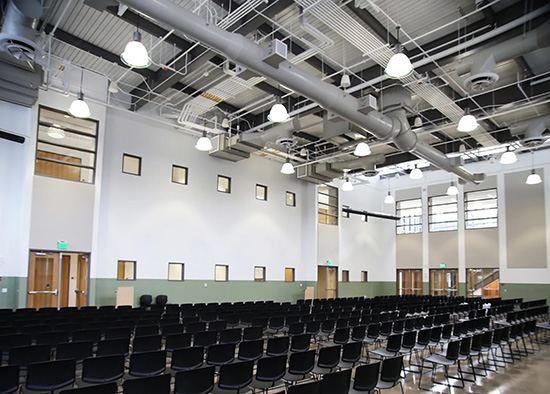|
Subscribe / Renew |
|
|
Contact Us |
|
| ► Subscribe to our Free Weekly Newsletter | |
| home | Welcome, sign in or click here to subscribe. | login |
Construction
| |
 |
February 6, 2023
Best In State: Gold Award
Future Value To The Engineering Profession

P2S Inc.
Project: Thurston County Readiness Center
Client: Washington Army National Guard
The new Thurston County Readiness Center is a specialized training and emergency response facility serving the Washington National Guard 2nd Battalion, 146th Field Artillery Regiment. The 80,000-square-foot center provides the unit with multiple training areas, maintenance bays, a 6,400-square-foot drill floor, fitness rooms, a state-of-the-art kitchen and dining area, and ample spaces for collaboration and comradery building among the soldiers.
This building has a widely variable occupant load with around 20 core occupants that use the building as a home base for their office environment, increasing to several hundred during a training event (or if there were to be an actual emergency).
The P2S engineers carefully considered how all areas of the building would be used while designing dynamic and energy-efficient systems for heating, cooling, water usage, commercial cooking, and emergency systems. This new system also needed to meet or exceed LEED Silver standards.
The plumbing engineers designed a modular approach to producing hot water. There is a 20- to 30-fold difference between the typical hot water demand and during an “event.” The water heating system uses an array of instantaneous water heaters and a storage tank. This array of instantaneous heaters can simultaneously respond to a low demand for just a few lavatories or a high demand for 20 showers and a commercial kitchen. This engineering approach conserves energy compared to using conventional domestic hot water tanks.
The facility’s mechanical system design incorporates several sustainable features, building on a comprehensive energy life-cycle cost analysis. This HVAC system using variable refrigerant flow (VRF) with energy recovery ventilation can provide a 43% annual cost reduction compared to a baseline building HVAC system.
Additional sustainable design features for this facility include 30% water savings through low-flow fixtures, and indoor air quality controls that monitor and automatically respond to ensure excellent air quality. Seismic positional retention systems, a backup generator, and a propane utility plant that can synthesize natural gas provide resiliency in the case of an emergency.
The facility also houses the “Firefinder” radar system — specialized equipment stored in a heated space inside the building’s maintenance area, ventilated by both general exhaust and vehicle exhaust snorkel explicitly designed for the Firefinder equipment area.
P2S’s systems design exceeded the owner’s goal for a Silver LEED building, while providing a cost-effective solution aligned with the forecasted budgeting. This building represents excellent value to the National Guard, the state of Washington and the taxpayers that provide funding.
Other Stories:
- National Finalist: Platinum Award
Transportation - Best In State: Gold Award
Social, Economic And Sustainable Design - Best In State: Gold Award
Complexity - Best In State: Gold Award
Exceeding Client/Owner Expectations - Best In State: Gold Award
Unique Or Innovative Application Of New Or Existing Techniques - National Finalist: Gold Award
Surveying/Mapping Technology - National Finalist: Gold Award
Special Projects - National Finalist: Gold Award
Structural Systems - National Finalist: Gold Award
Structural Systems - Diversity And Inclusion Award: Mid-Sized Firm
- Diversity And Inclusion Award: Large Firm
- Engineer of the Year
- National Finalist: Gold Award
Transportation


